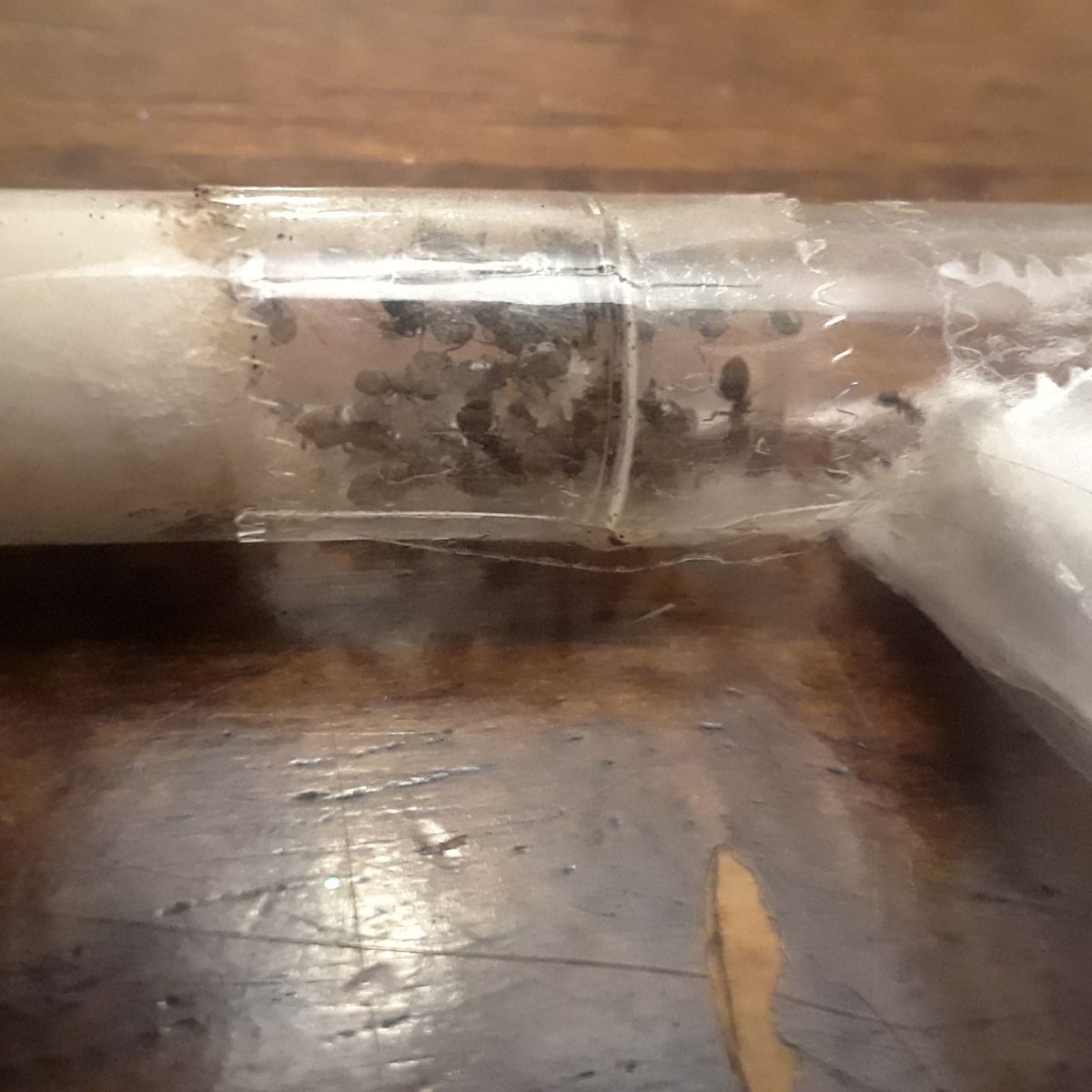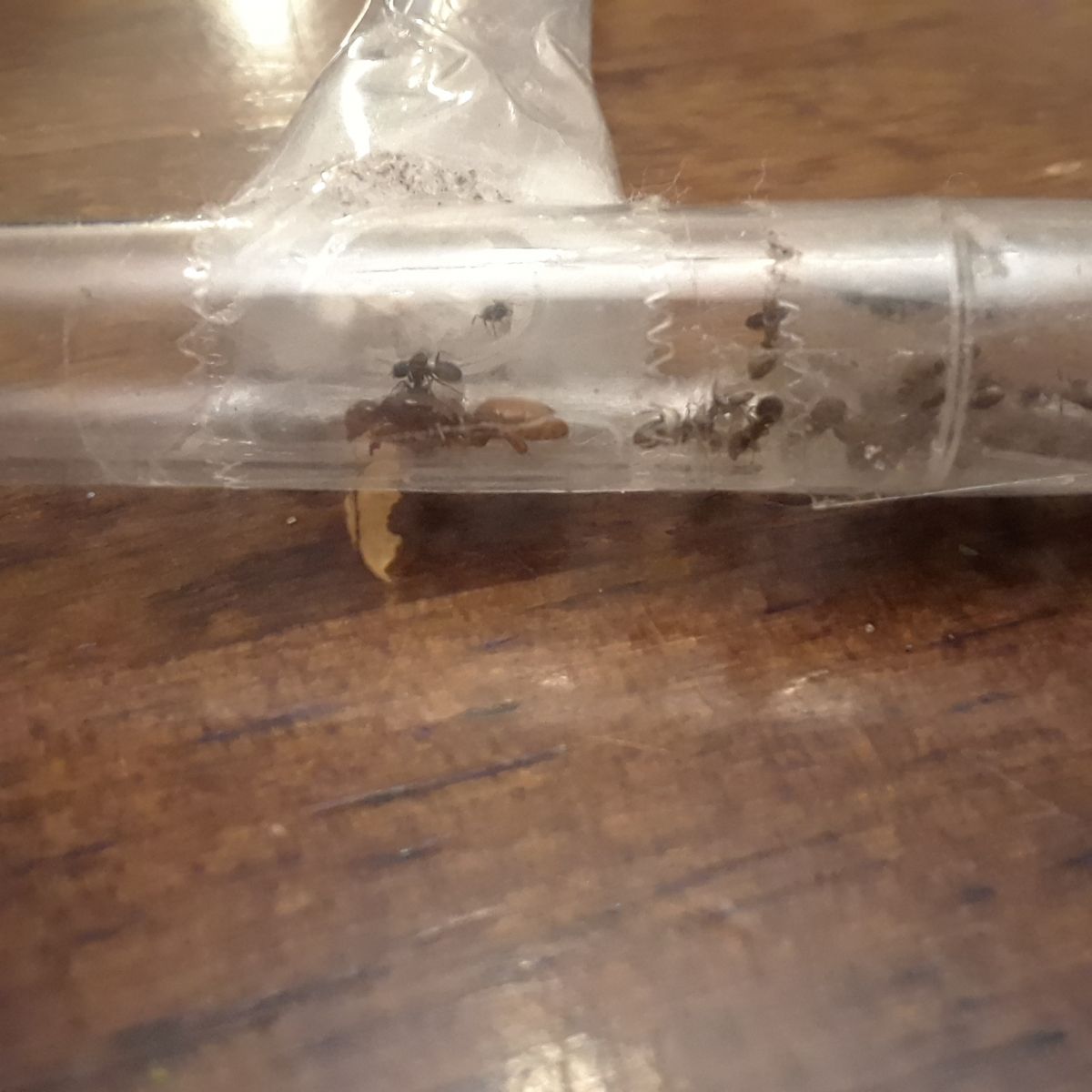Lasius latipesI've posted a couple of pictures of my Lasius latipes queen and her brood, along with the host colony. Before I get ahead of myself, however, I'll share some details regarding when and where I caught her. Capture Date: 9-12-17Location: Northeastern Michigan (lower peninsula) on the sidewalk in front of my house. These queens were everywhere.I caught her along with over 40 other various Lasius queens that day. I let most of them go, and kept 12. She is the only latipes queen remaining out of the 4 I kept of this species, the other 3 died about a week ago. Subsequently, she is the only one that I placed in a host colony. The other 3 I kept in a test tube setup and planned on hibernating them for the winter in case this particular queen didn't survive the introduction to the host colony. It seems the tables turned on me regarding that situation. Anyways, I went behind my house and flipped a few flat bricks because I knew there were a few Lasius colonies that I had seen weeks before living under some of them. I knew this because I saw queen alates scrambling back into their nest when I was lifting the bricks back then. I also saw a lot of pupae during that time. When I went back to capture some of those workers, I simply took a very large bowl (with an ant proofed rim) and grabbed a handful of the dirt/pupae/workers sitting under the brick and put it into the bowl. I found that the easiest way to recover the workers from the dirt in the bowl was to slowly stir the dirt to uncover them, and then use a test tube to trap them on the side of the bowl and wait until they climbed to the top of the tube, then simply transfer them to another temporary container. Once I dug out all of the workers (there ended up being 15 or so) I put two of them into the tube with my latipes queen. I didn't chill them, or do anything special, I just put them in there with her. Obviously the reaction went as expected, I had to separate them because I thought they were going to kill my queen. I then proceeded to recover the pupae from the dirt. I used a wet Q-tip that the eggs stuck to quite nicely. Once I cleared the surface dirt of eggs, I mixed the soil back up and repeated the process of excavating pupae until I couldn't find anymore. I then put all of the pupae (and only the pupae) into the tube with the latipes queen for about an hour or so, and then I reintroduced the two workers from before. I think she picked up some of the pheromones from the pupae, because this introduction went much, much better. The workers investigated her a little, but didn't attack. A few minutes later they were trying to move the pupae around. I waited until the next day so that the queen could pick up more pheromones from the eggs and workers, and then introduced a few more new workers and it went off without a hitch. They were slightly curious, but soon lost interest in the queen. I then added all of the rest of the workers one by one to see their reactions. They were the same. I felt pretty good and left it for about three days and hoped for the best. I read (I believe on this very thread) that once a parasitic queen had been accepted into a colony she will lay more eggs, or less, depending on the size of the host colony. I also saw on here that it is recommended to have 20+ host workers, and I knew that I was a tad shy of that not counting the host pupae. So I went out and flipped the brick next to the one where I first collected a handful of dirt, ants and pupae and did the process a second time. This time all of the new workers accepted the parasitic queen like she was their own, and immediately started moving brood around without a second thought dedicated to the latipes queen, or the first batch of host workers and pupae. This boosted my workers to 40ish, and added to the collection of host pupae. Fast forward to a few days ago (9-30-17),I finally got a 15w heating cable and ran it under their makeshift formicarium. I added that detail because it may have been a contributor to what came next. . . On 10-2-17, nearly 3 weeks since I first caught my queen (I was beginning to wonder if I had to hibernate her before she would lay eggs) I noticed what I thought was torn cotton stuck to the top of the test tube. On further inspection it turned out to be a small pile of eggs. Once I moved the tube so that I could take a look on the bottom, I noticed another larger pile of eggs down there.
I used small plastic test tubes for this, 3 x 0.5 x 0.5 inches. Taped two together end to end, one for water and the other for living space. Then I drilled a small hole (big enough for the queen to fit through) inside of the empty tube used for living space, and taped a 6" piece of 1/8" ( inside diameter) clear vinyl tubing to it so that they had plenty of room to move the host brood around if they wanted to. I then placed the entire set up into a clear rectangular plastic cage that my kids used to use for hermit crabs. Once the rim was ant proofed, I placed a plastic dish with cotton balls in the corner of it that I keep moist for extra hydration if the ants need it. Now I see that the ants have put some of the unhatched pupae under the moist cotton. This happened around the same time that I noticed the new batch of eggs. In fact, the new eggs are where they used to keep the pupae, so maybe that's why they pupae got moved to the dish with the moist cotton balls outside of the test tubes. I've also been feeding the colony since day 5 or 6, right after the entirety of the first batch of host workers got successfully introduced. I've been feeding all sorts of things, such as honey, sugar water, candy, cat food, dog food, chicken, beef pot roast, spider, etc.
That's about all I can think of. There's probably way too many details in all of this than necessary, but I want to give as
much information as I can in case anyone wants to replicate it since it has been successful thus far. As I've stated in my last post, the colony will need to survive hibernation, and the eggs will need to actually hatch so that I know they are fertile, before I officially declare this ordeal a success.
Feel free to post any questions, or send me a PM. I'll do my best to help, but know that I'm going on beginners luck with a majority of this.
You can see the larger pile of eggs just to the left of where the two tubes come together.

And here is the queen in all of her glory.

Edited by Jamiesname, October 4 2017 - 2:45 PM.






















